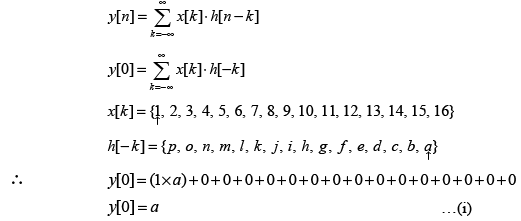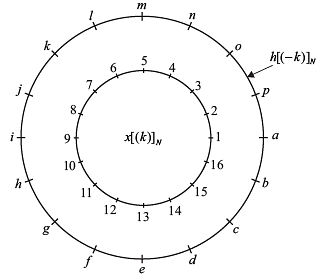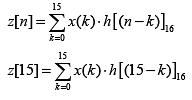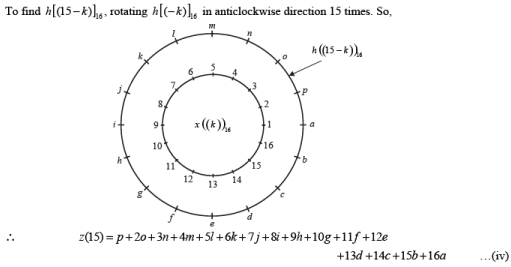Electronics and Communication Engineering (ECE) Exam > Electronics and Communication Engineering (ECE) Questions > Consider two 16 point sequences x[n] and h[n...
Start Learning for Free
Consider two 16 point sequences x[n] and h[n]. Let the linear convolution x[n] and h[n] be denoted by y [n] , while z [n] denotes the 16 point inverse discrete Fourier transform (IDFT) of the product of the 16 point DFTs of x [ n] and h [n] . The value(s) of k for which z [k] = y [ k ] is/are
- a)k = 0,1, 2, .....,15
- b)k = 0
- c)k = 15
- d)k = 0 or 15
Correct answer is option 'C'. Can you explain this answer?
| FREE This question is part of | Download PDF Attempt this Test |
Most Upvoted Answer
Consider two 16 point sequences x[n] and h[n]. Let the linear convolu...
Given:
- Two 16-point sequences x[n] and h[n]
- Linear convolution of x[n] and h[n] denoted as y[n]
- z[n] denotes the 16-point inverse discrete Fourier transform (IDFT) of the product of the 16-point DFTs of x[n] and h[n]
To Find: The value(s) of k for which z[k] = y[k]
Solution:
To find the value(s) of k for which z[k] = y[k], we need to understand the relationship between linear convolution and the inverse discrete Fourier transform.
Linear Convolution:
Linear convolution is a mathematical operation that combines two sequences by multiplying corresponding elements and summing the results. The linear convolution of two sequences x[n] and h[n] is denoted as y[n] and can be calculated using the following equation:
y[n] = ∑(x[k] * h[n-k])
where k ranges from 0 to N-1, and N is the length of the sequences.
Inverse Discrete Fourier Transform (IDFT):
The inverse discrete Fourier transform (IDFT) is a mathematical operation that transforms a sequence from the frequency domain to the time domain. It is the reverse operation of the discrete Fourier transform (DFT). The IDFT of a sequence X[k] is denoted as x[n] and can be calculated using the following equation:
x[n] = (1/N) * ∑(X[k] * e^(j*2πkn/N))
where k ranges from 0 to N-1, and N is the length of the sequences.
Relationship between Linear Convolution and IDFT:
The relationship between linear convolution and the IDFT can be expressed as follows:
z[n] = IDFT(DFT(x[n]) * DFT(h[n]))
In other words, the IDFT of the product of the DFTs of x[n] and h[n] gives us the linear convolution of x[n] and h[n].
Value(s) of k for which z[k] = y[k]:
To find the value(s) of k for which z[k] = y[k], we need to compare the values of z[k] and y[k] for all values of k.
Given that z[n] is the IDFT of the product of the DFTs of x[n] and h[n], it is equal to the linear convolution y[n].
Therefore, z[k] = y[k] for all values of k.
Hence, the correct answer is option 'C' - k = 15.
- Two 16-point sequences x[n] and h[n]
- Linear convolution of x[n] and h[n] denoted as y[n]
- z[n] denotes the 16-point inverse discrete Fourier transform (IDFT) of the product of the 16-point DFTs of x[n] and h[n]
To Find: The value(s) of k for which z[k] = y[k]
Solution:
To find the value(s) of k for which z[k] = y[k], we need to understand the relationship between linear convolution and the inverse discrete Fourier transform.
Linear Convolution:
Linear convolution is a mathematical operation that combines two sequences by multiplying corresponding elements and summing the results. The linear convolution of two sequences x[n] and h[n] is denoted as y[n] and can be calculated using the following equation:
y[n] = ∑(x[k] * h[n-k])
where k ranges from 0 to N-1, and N is the length of the sequences.
Inverse Discrete Fourier Transform (IDFT):
The inverse discrete Fourier transform (IDFT) is a mathematical operation that transforms a sequence from the frequency domain to the time domain. It is the reverse operation of the discrete Fourier transform (DFT). The IDFT of a sequence X[k] is denoted as x[n] and can be calculated using the following equation:
x[n] = (1/N) * ∑(X[k] * e^(j*2πkn/N))
where k ranges from 0 to N-1, and N is the length of the sequences.
Relationship between Linear Convolution and IDFT:
The relationship between linear convolution and the IDFT can be expressed as follows:
z[n] = IDFT(DFT(x[n]) * DFT(h[n]))
In other words, the IDFT of the product of the DFTs of x[n] and h[n] gives us the linear convolution of x[n] and h[n].
Value(s) of k for which z[k] = y[k]:
To find the value(s) of k for which z[k] = y[k], we need to compare the values of z[k] and y[k] for all values of k.
Given that z[n] is the IDFT of the product of the DFTs of x[n] and h[n], it is equal to the linear convolution y[n].
Therefore, z[k] = y[k] for all values of k.
Hence, the correct answer is option 'C' - k = 15.
Free Test
FREE
| Start Free Test |
Community Answer
Consider two 16 point sequences x[n] and h[n]. Let the linear convolu...
Given : x[n] and h[n] are 16 point sequences












and y[n] = x[n]⊗ h[ n] …(i)
Also, z[n] = IDFT [ X (k )⋅ H (k )]


From circular convolution property of DFT.

We have to find value of k , for which y (k) = z (k ) .
i.e., value of n , for which linear and circular convolutions of 16 point sequences x[n] and h[n] are same.
From definitions of linear convolution

From definitions of circular convolution,

Assuming two 16 point sequences as,

So, linear convolution y[n] is,

From 16 point circular convolution,


Thus, z(0) = (a×1) + (b × 2) +(c × 3) + (d × 4) +(e× 5) + ( f × 6) +(g × 7) +(h × 8) + (i × 9) + ( j×10) + (k ×11) + (l ×12) + (m ×13) + (n×14) +(o×15) + (p ×16) …(ii)
From equations (i) and (ii),
z(0) ≠y(0)
So, z(k) = y(k) is not satisfied for k = 0 and hence options (A), (B) and (D) are wrong.
Now we are choosing option (C) and verify it as follows,

To find h[15 −k ] , shifting sequence h(−k) 15 times towards right hand side.

Circular convolution,


From equation (iii) and (iv),
y(15) =z(15)
Hence, y(k) = z(k) for k = 15 is satisfied.
Hence, the correct option is (C).
Attention Electronics and Communication Engineering (ECE) Students!
To make sure you are not studying endlessly, EduRev has designed Electronics and Communication Engineering (ECE) study material, with Structured Courses, Videos, & Test Series. Plus get personalized analysis, doubt solving and improvement plans to achieve a great score in Electronics and Communication Engineering (ECE).

|
Explore Courses for Electronics and Communication Engineering (ECE) exam
|

|
Similar Electronics and Communication Engineering (ECE) Doubts
Consider two 16 point sequences x[n] and h[n]. Let the linear convolution x[n] and h[n] be denoted by y [n] , while z [n] denotes the 16 point inverse discrete Fourier transform (IDFT) of the product of the 16 point DFTs of x [ n] and h [n] . The value(s) of k for which z [k] = y [ k ] is/area)k = 0,1, 2, .....,15b)k = 0c)k = 15d)k = 0 or 15Correct answer is option 'C'. Can you explain this answer?
Question Description
Consider two 16 point sequences x[n] and h[n]. Let the linear convolution x[n] and h[n] be denoted by y [n] , while z [n] denotes the 16 point inverse discrete Fourier transform (IDFT) of the product of the 16 point DFTs of x [ n] and h [n] . The value(s) of k for which z [k] = y [ k ] is/area)k = 0,1, 2, .....,15b)k = 0c)k = 15d)k = 0 or 15Correct answer is option 'C'. Can you explain this answer? for Electronics and Communication Engineering (ECE) 2024 is part of Electronics and Communication Engineering (ECE) preparation. The Question and answers have been prepared according to the Electronics and Communication Engineering (ECE) exam syllabus. Information about Consider two 16 point sequences x[n] and h[n]. Let the linear convolution x[n] and h[n] be denoted by y [n] , while z [n] denotes the 16 point inverse discrete Fourier transform (IDFT) of the product of the 16 point DFTs of x [ n] and h [n] . The value(s) of k for which z [k] = y [ k ] is/area)k = 0,1, 2, .....,15b)k = 0c)k = 15d)k = 0 or 15Correct answer is option 'C'. Can you explain this answer? covers all topics & solutions for Electronics and Communication Engineering (ECE) 2024 Exam. Find important definitions, questions, meanings, examples, exercises and tests below for Consider two 16 point sequences x[n] and h[n]. Let the linear convolution x[n] and h[n] be denoted by y [n] , while z [n] denotes the 16 point inverse discrete Fourier transform (IDFT) of the product of the 16 point DFTs of x [ n] and h [n] . The value(s) of k for which z [k] = y [ k ] is/area)k = 0,1, 2, .....,15b)k = 0c)k = 15d)k = 0 or 15Correct answer is option 'C'. Can you explain this answer?.
Consider two 16 point sequences x[n] and h[n]. Let the linear convolution x[n] and h[n] be denoted by y [n] , while z [n] denotes the 16 point inverse discrete Fourier transform (IDFT) of the product of the 16 point DFTs of x [ n] and h [n] . The value(s) of k for which z [k] = y [ k ] is/area)k = 0,1, 2, .....,15b)k = 0c)k = 15d)k = 0 or 15Correct answer is option 'C'. Can you explain this answer? for Electronics and Communication Engineering (ECE) 2024 is part of Electronics and Communication Engineering (ECE) preparation. The Question and answers have been prepared according to the Electronics and Communication Engineering (ECE) exam syllabus. Information about Consider two 16 point sequences x[n] and h[n]. Let the linear convolution x[n] and h[n] be denoted by y [n] , while z [n] denotes the 16 point inverse discrete Fourier transform (IDFT) of the product of the 16 point DFTs of x [ n] and h [n] . The value(s) of k for which z [k] = y [ k ] is/area)k = 0,1, 2, .....,15b)k = 0c)k = 15d)k = 0 or 15Correct answer is option 'C'. Can you explain this answer? covers all topics & solutions for Electronics and Communication Engineering (ECE) 2024 Exam. Find important definitions, questions, meanings, examples, exercises and tests below for Consider two 16 point sequences x[n] and h[n]. Let the linear convolution x[n] and h[n] be denoted by y [n] , while z [n] denotes the 16 point inverse discrete Fourier transform (IDFT) of the product of the 16 point DFTs of x [ n] and h [n] . The value(s) of k for which z [k] = y [ k ] is/area)k = 0,1, 2, .....,15b)k = 0c)k = 15d)k = 0 or 15Correct answer is option 'C'. Can you explain this answer?.
Solutions for Consider two 16 point sequences x[n] and h[n]. Let the linear convolution x[n] and h[n] be denoted by y [n] , while z [n] denotes the 16 point inverse discrete Fourier transform (IDFT) of the product of the 16 point DFTs of x [ n] and h [n] . The value(s) of k for which z [k] = y [ k ] is/area)k = 0,1, 2, .....,15b)k = 0c)k = 15d)k = 0 or 15Correct answer is option 'C'. Can you explain this answer? in English & in Hindi are available as part of our courses for Electronics and Communication Engineering (ECE).
Download more important topics, notes, lectures and mock test series for Electronics and Communication Engineering (ECE) Exam by signing up for free.
Here you can find the meaning of Consider two 16 point sequences x[n] and h[n]. Let the linear convolution x[n] and h[n] be denoted by y [n] , while z [n] denotes the 16 point inverse discrete Fourier transform (IDFT) of the product of the 16 point DFTs of x [ n] and h [n] . The value(s) of k for which z [k] = y [ k ] is/area)k = 0,1, 2, .....,15b)k = 0c)k = 15d)k = 0 or 15Correct answer is option 'C'. Can you explain this answer? defined & explained in the simplest way possible. Besides giving the explanation of
Consider two 16 point sequences x[n] and h[n]. Let the linear convolution x[n] and h[n] be denoted by y [n] , while z [n] denotes the 16 point inverse discrete Fourier transform (IDFT) of the product of the 16 point DFTs of x [ n] and h [n] . The value(s) of k for which z [k] = y [ k ] is/area)k = 0,1, 2, .....,15b)k = 0c)k = 15d)k = 0 or 15Correct answer is option 'C'. Can you explain this answer?, a detailed solution for Consider two 16 point sequences x[n] and h[n]. Let the linear convolution x[n] and h[n] be denoted by y [n] , while z [n] denotes the 16 point inverse discrete Fourier transform (IDFT) of the product of the 16 point DFTs of x [ n] and h [n] . The value(s) of k for which z [k] = y [ k ] is/area)k = 0,1, 2, .....,15b)k = 0c)k = 15d)k = 0 or 15Correct answer is option 'C'. Can you explain this answer? has been provided alongside types of Consider two 16 point sequences x[n] and h[n]. Let the linear convolution x[n] and h[n] be denoted by y [n] , while z [n] denotes the 16 point inverse discrete Fourier transform (IDFT) of the product of the 16 point DFTs of x [ n] and h [n] . The value(s) of k for which z [k] = y [ k ] is/area)k = 0,1, 2, .....,15b)k = 0c)k = 15d)k = 0 or 15Correct answer is option 'C'. Can you explain this answer? theory, EduRev gives you an
ample number of questions to practice Consider two 16 point sequences x[n] and h[n]. Let the linear convolution x[n] and h[n] be denoted by y [n] , while z [n] denotes the 16 point inverse discrete Fourier transform (IDFT) of the product of the 16 point DFTs of x [ n] and h [n] . The value(s) of k for which z [k] = y [ k ] is/area)k = 0,1, 2, .....,15b)k = 0c)k = 15d)k = 0 or 15Correct answer is option 'C'. Can you explain this answer? tests, examples and also practice Electronics and Communication Engineering (ECE) tests.

|
Explore Courses for Electronics and Communication Engineering (ECE) exam
|

|
Suggested Free Tests
Signup for Free!
Signup to see your scores go up within 7 days! Learn & Practice with 1000+ FREE Notes, Videos & Tests.
























